How Society 5.0 and Industry 4.0 Ideas Shape the Open Data Performance Expectancy
Abstract
1. Introduction
- Identifying the relationship between open data, Society 5.0 and Industry 4.0 to provide the context for open data’s performance expectancy for open data usage acceptance models’ research development;
- Identifying the trends and key words (leading terms) in promoting open data for the application of open data in Industry 4.0 and Society 5.0;
- Identifying leaders in Europe in promoting the use of open data in the context of Industry 4.0 and Society 5.0.
- RQ1: How are the products and services created on the basis of open data presented? What terms are dominating in the descriptions of presented case studies?
- RQ2: How are products and services created on the basis of open data promoted in particular parts of Europe? Are there similarities between those geographical areas?
- RQ3: What kinds of open data are most frequently used? Are there similarities between the different geographical areas of Europe in this respect?
2. Literature Review
2.1. Open Data, Society 5.0 and Industry 4.0 Relationship
2.2. Open Data Performance Expectancy
3. Materials and Methods
3.1. Conceptual Scheme of Research Elaboration
3.1.1. Stage 1: Collecting Data
3.1.2. Stage 2: Processing of Text Variables
3.1.3. Stage 3: Creating Subsets and Searching for Similarities between Them
4. Results
4.1. Description of Research Sample
4.2. Terms that Dominate in Descriptions of Products and Services Using Open Data
4.3. Analysis of Terms in a Geographical Context—Finding Similarities between Regions
4.4. Types of Open Data Used in Products and Services
5. Discussion
6. Conclusions
Author Contributions
Funding
Data Availability Statement
Conflicts of Interest
References
- Abramowicz, W.; Węcel, K. Should Business Informatics Care about Linked Open Data? In Lecture Notes in Business Information Processing—BIR 2013: Perspectives in Business Informatics Research, Proceedings of the 12th International Conference, BIR 2013, Warsaw, Poland, 23–25 September 2013; Kobyliński, A., Sobczak, A., Eds.; Springer: Berlin/Heidelberg, Germany, 2013; Volume 158, Available online: https://doi.org/10.1007/978-3-642-40823-6 (accessed on 12 December 2020).
- Berners-Lee, T. Linked Data—Design Issues, W3C; ACM Press: New York, NY, USA, 2006; Volume 7. [Google Scholar]
- Węcel, K. Procurement in Linked Open Data Paradigm. In Technologie Wiedzy w Zarządzaniu Publicznym 2013; Gołuchowski, J., Frączkiewicz-Wronka, A., Eds.; University of Economics in Katowice: Katowice, Poland, 2014; Volume 199, pp. 338–348. [Google Scholar]
- Mishra, D.; Mishra, A. Sustainability Inclusion in Informatics Curriculum Development. Sustainability 2020, 12, 5769. [Google Scholar] [CrossRef]
- Szarek-Iwaniuk, P.; Senetra, A. Access to ICT in Poland and the Co-Creation of Urban Space in the Process of Modern Social Participation in a Smart City—A Case Study. Sustainability 2020, 12, 2136. [Google Scholar] [CrossRef]
- Tolstykh, T.; Shmeleva, N.; Gamidullaeva, L. Evaluation of Circular and Integration Potentials of Innovation Ecosystems for Industrial Sustainability. Sustainability 2020, 12, 4574. [Google Scholar] [CrossRef]
- Chignard, S. A Brief History of Open Data, Paris Tech Review. 29 March 2013. Available online: http://www.paristechreview.com/2013/03/29/brief-history-open-data/ (accessed on 12 December 2020).
- Kożuch, B.; Sienkiewicz-Małyjurek, K. Information Sharing in Complex Systems: A Case Study on Public Safety Management. Procedia Soc. Behav. Sci. 2015, 213, 722–727. [Google Scholar] [CrossRef]
- Salloum, S.A.; Al-Emran, M.; Shaalan, K. The Impact of Knowledge Sharing on Information Systems: A Review. In Communications in Computer and Infor-mation Science—KMO 2018: Knowledge Management in Organizations, Proceedings of the International Conference on Knowledge Management in Organizations, Žilina, Slovakia, 6–10 August 2018; Uden, L., Hadzima, B., Ting, I.H., Eds.; Springer: Cham, Switzerland, 2018; Volume 877. [Google Scholar] [CrossRef]
- Marcos, E.; De Castro, V.; Martín-Peña, M.; Vara, J.M. Training New Professionals in Service Engineering: Towards a Transdisciplinary Curriculum for Sustainable Businesses. Sustainability 2020, 12, 8289. [Google Scholar] [CrossRef]
- Kitchin, R. The Data Revolution: Big Data, Open Data, Data Infrastructures and Their Consequences; Sage: London, UK, 2014. [Google Scholar]
- Mourtzis, D. Development of Skills and Competences in Manufacturing towards Education 4.0: A Teaching Factory Approach. In Proceedings of the 3rd International Conference on the Industry 4.0 Model for Advanced Manufacturing, AMP 2018, Belgrade, Serbia, 5–7 June 2018; Lecture Notes in Mechanical Engineering. Ni, J., Majstorovic, V., Djurdjanovic, D., Eds.; Springer: Cham, Switzerland, 2018. [Google Scholar] [CrossRef]
- Al Mansoori, S.; Salloum, S.A.; Shaalan, K. The Impact of Artificial Intelligence and Information Technologies on the Efficiency of Knowledge Management at Modern Organizations: A Systematic Review. In Recent Advances in Intelligent Systems and Smart Applications; Studies in Systems, Decision and Control Book Serious; Al-Emran, M., Shaalan, K., Hassanien, A., Eds.; Springer: Cham, Switzerland, 2021; Volume 295. [Google Scholar] [CrossRef]
- Gagliardi, D.; Schina, L.; Sarcinella, M.L.; Mangialardi, G.; Niglia, F.; Corallo, A. Information and communication technologies and public participation: Interactive maps and value added for citizens. Gov. Inf. Q. 2017, 34, 153–166. [Google Scholar] [CrossRef]
- Afful-Dadzie, E.; Afful-Dadzie, A. Liberation of public data: Exploring central themes in open government data and freedom of information research. Int. J. Inf. Manag. 2017, 37, 664–672. [Google Scholar] [CrossRef]
- Janssen, M.; van den Hoven, J. Big and Open Linked Data (BOLD) in Government: A Challenge to Transparency and Privacy? Gov. Inf. Q. 2015, 32, 363–368. [Google Scholar] [CrossRef]
- Zuiderwijk, A.; Janssen, M.; Dwivedi, Y.K. Acceptance and use predictors of open data technologies: Drawing upon the unified theory of acceptance and use of technology. Gov. Inf. Q. 2015, 32, 429–440. [Google Scholar] [CrossRef]
- Huyer, E. The Economic Impact of Open Data Opportunities for Value Creation in Europe. Available online: https://www.europeandataportal.eu/en/highlights/the-economic-impact-of-open-data (accessed on 12 December 2020).
- Verhulst, S.; Young, A. Open Data Impact When Demand and Supply Meet. Key Finding of the Open Data Impact Cases Studies. Opgehaald van. Available online: http://odimpact.org/key-findings.html (accessed on 12 December 2020).
- Zeleti, F.A.; Ojo, A.; Curry, E. Exploring the economic value of open government data. Gov. Inf. Q. 2016, 33, 535–551. [Google Scholar] [CrossRef]
- Carrara, W.; Chan, W.S.; Fischer, S.; Steenbergen, E.V. Creating Value Through Open Data. European Commission. 2015. Available online: https://www.europeandataportal.eu/sites/default/files/edp_creating_value_through_open_data_0.pdf (accessed on 12 December 2020).
- Worthy, B. The impact of open data in the UK: Complex, unpredictable, and political. Public Adm. 2015, 93, 788–805. [Google Scholar] [CrossRef]
- Jetzek, T.; Avital, M.; Bjørn-Andersen, N. Generating value from open government data. In Proceedings of the Thirty Fourth International Conference on Information Systems, Milan, Italy, 15–18 December 2013. [Google Scholar]
- Jetzek, T.; Avital, M.; Bjorn-Andersen, N. Data-driven innovation through open government data. J. Theor. Appl. Electron. Commer. Res. 2014, 9, 15–16. [Google Scholar] [CrossRef]
- Janssen, M.; Charalabidis, Y.; Zuijderwijk, A. Benefifits, adoption barriers and myths of open data and open government. Inf. Syst. Manag. 2012, 29, 258–268. [Google Scholar] [CrossRef]
- Ruijer, E.; Grimmelikhuijsen, S.; van den Berg, J.; Meijer, A. Open data work: Understanding open data usage from a practice lens. Int. Rev. Adm. Sci. 2020, 86, 3–19. [Google Scholar] [CrossRef]
- Ruijer, E.; Grimmelikhuijsen, S.; Meijer, A. Open data for democracy: Developing a theoretical framework for open data use. Gov. Inf. Q. 2017, 34, 45–52. [Google Scholar] [CrossRef]
- Ruijer, E.; Martinius, E. Researching the democratic impact of open government data: A systematic literature review. Inf. Polity 2017, 22, 233–250. [Google Scholar] [CrossRef]
- Sivarajah, U.; Weerakkody, V.; Waller, P.; Lee, H.; Irani, Z.; Choi, Y.; Morgan, R.; Glikman, Y. The role of e-participation and open data in evidence-based policy decision making in local government. J. Organ. Comput. Electron. Commer. 2015, 26, 64–79. [Google Scholar] [CrossRef]
- Dawes, S.; Helbig, N. Information strategies for open government: Challenges and prospects for deriving public value from government transparency. Electron. Gov. 2010, 6228, 50–60. [Google Scholar]
- Salas, D.; Liang, X.; Navarro, M.; Liang, Y.; Luna, D. An open-data open-model framework for hydrological models integration, evaluation and application. Environ. Model. Softw. 2020, 126, 104622. [Google Scholar] [CrossRef]
- Rantala, S.; Swallow, B.; Paloniemi, R.; Raitanen, E. Governance of forests and governance of forest information: Interlinkages in the age of open and digital data. For. Policy Econ. 2020, 113, 102123. [Google Scholar] [CrossRef]
- Pafi, M.; Chalkias, C.; Stathakis, D. A cost-effective method for tranquility mapping using open environmental data. Environ. Plan. B-Urban Anal. City Sci. 2020, 47, 417–436. [Google Scholar] [CrossRef]
- Blank, M. Open Data Maturity Report 2019. Available online: https://www.europeandataportal.eu/sites/default/files/open_data_maturity_report_2019.pdf (accessed on 12 December 2020).
- Cecconi, G.; Radu, C. Open Data Maturity Report 2018. Available online: https://www.europeandataportal.eu/sites/default/files/edp_landscaping_insight_report_n4_2018.pdf (accessed on 12 December 2020).
- Open Data in Europe 2019. Available online: https://www.europeandataportal.eu/en/dashboard/2019 (accessed on 12 December 2020).
- Open Data in Europe 2018. Available online: https://www.europeandataportal.eu/en/dashboard/2018 (accessed on 12 December 2020).
- Open Data in Europe 2017. Available online: https://www.europeandataportal.eu/en/dashboard/2017 (accessed on 12 December 2020).
- Open Data in Europe 2016. Available online: https://www.europeandataportal.eu/en/dashboard/2016 (accessed on 12 December 2020).
- Vetro, A.; Canova, L.; Torchiano, M.; Minotas, C.O.; Iemma, R.; Morando, F. Open data quality measurement framework: Def-inition and application to Open Government Data. Gov. Inf. Q. 2016, 33, 325–337. [Google Scholar] [CrossRef]
- Zuiderwijk, A.; Janssen, M. Participation and data quality in open data use: Open data infrastructures evaluated. In Proceedings of the 15th European Conference on eGovernment 2015: ECEG 2015, Portsmouth, UK, 18–19 June 2015; Academic Conferences Limited: Reading, UK, 2015. [Google Scholar]
- Zdonek, I.; Soltysik-Piorunkiewicz, A. Directions of Shaping the Open Data Performance Expectancy in Europe In the Light of Text Mining Analysis. In Proceedings of the 36th International Business Information Management Association (IBIMA), Granada, Spain, 4–5 November 2020; ISBN 978-0-9998551-5-7. [Google Scholar]
- 5*Open Data. Available online: https://5stardata.info/en/ (accessed on 12 December 2020).
- Place Overview—Global Open Data Index (okfn.org). Available online: https://index.okfn.org/ (accessed on 12 December 2020).
- LOD Cloud (lod-cloud.net). Available online: https://lod-cloud.net/ (accessed on 12 December 2020).
- Soylu, A.; Elvesæter, B.; Turk, P.; Roman, D.; Corcho, O.; Simperl, E.; Konstantinidis, G.; Lech, T.C. Towards an Ontology for Public Procurement Based on the Open Contracting Data Standard. In I3E 2019: Digital Transformation for a Sustainable Society in the 21st Century, Proceedings of the Conference on e-Business, e-Services and e-Society, Trondheim, Norway, 18–20 September 2019; Lecture Notes in Computer Science book series; Pappas, I., Mikalef, P., Dwivedi, Y., Jaccheri, L., Krogstie, J., Mäntymäki, M., Eds.; Springer: Cham, Switzerland, 2019; Volume 11701, pp. 230–237. [Google Scholar] [CrossRef]
- Nečaský, M.; Klímek, J.; Mynarz, J.; Knap, T.; Svátek, V.; Stárka, J. Linked data support for filing public contracts. Comput. Ind. 2014, 65, 862–877. [Google Scholar] [CrossRef]
- Webster, F. Theories of the Information Society; Routledge: London, UK, 2014. [Google Scholar]
- Fuchs, C. Sustainability and the Information Society. In HCC 2006: Social Informatics: An Information Society for All? In Remembrance of Rob Kling, Proceedings of the IFIP International Conference on Human Choice and Computers, Maribor, Slovenia, 21–23 September 2006; Berleur, J., Nurminen, M.I., Impagliazzo, J., Eds.; Springer: Boston, MA, USA, 2006. [Google Scholar] [CrossRef]
- Wątróbski, J.; Ziemba, E.; Karczmarczyk, A.; Jankowski, J. An Index to Measure the Sustainable Information Society: The Polish Households Case. Sustainability 2018, 10, 3223. [Google Scholar] [CrossRef]
- Keidanren. Japan Business Federation, Toward Realization of the New Economy and Society. Available online: https://www.keidanren.or.jp/en/policy/2016/029_outline.pdf (accessed on 12 December 2020).
- Aquilani, B.; Piccarozzi, M.; Abbate, T.; Codini, A. The Role of Open Innovation and Value Co-creation in the Challenging Transition from Industry 4.0 to Society 5.0: Toward a Theoretical Framework. Sustainability 2020, 12, 8943. [Google Scholar] [CrossRef]
- Kayikci, Y. Sustainability impact of digitization in logistic. Procedia Manuf. 2018, 21, 782–789. [Google Scholar] [CrossRef]
- Du Vall, M. Super inteligentne społeczeństwo skoncentrowane na ludziach, czyli o idei społeczeństwa 5.0 słów kilka. Państwo Społeczeństwo 2019, 19, 11–31. [Google Scholar] [CrossRef]
- Fukuyama, M. Society 5.0: Aiming for a New Human-Centered Society. Available online: https://www.jef.or.jp/journal/pdf/220th_Special_Article_02.pdf (accessed on 12 December 2020).
- Keidanren. Japan Business Federation, Society 5.0—Co-Creating the Future. 2018. Available online: http://www.keidanren.or.jp/en/policy/2018/095.html (accessed on 12 December 2020).
- Saniuk, S.; Saniuk, A.; Cagáňová, D. Cyber Industry Networks as an environment of the Industry 4.0 implementation. Wirel. Netw. 2019, 1–7. [Google Scholar] [CrossRef]
- Zhong, R.Y.; Xu, X.; Klotz, E.; Newman, S.T. Intelligent Manufacturing in the Context of Industry 4.0: A Review. Engineering 2017, 3, 616–630. [Google Scholar] [CrossRef]
- Miśkiewicz, R.; Wolniak, R. Practical Application of the Industry 4.0 Concept in a Steel Company. Sustainability 2020, 12, 5776. [Google Scholar] [CrossRef]
- Rao, S.K.; Prasad, R. Impact of 5G Technologies on Industry 4.0. Wirel. Pers. Commun. 2018, 100, 145–159. [Google Scholar] [CrossRef]
- Michna, A.; Kmieciak, R. Open-Mindedness Culture, Knowledge-Sharing, Financial Performance, and Industry 4.0 in SMEs. Sustainability 2020, 12, 9041. [Google Scholar] [CrossRef]
- Kagermann, H.; Wahlster, W.; Helbig, J. Recommendations for Implementing the Strategic Initiative Industrie 4.0—Final Report of the Industrie 4.0 Working Group; Communication Promoters Group of the Industry-Science Research: Frankfurt/Main, Germany, 2013. [Google Scholar]
- Qin, J.; Liu, Y.; Grosvenor, R. A categorical framework of manufacturing for Industry 4.0 and beyond. Procedia Cirp 2016, 52, 173–178. [Google Scholar] [CrossRef]
- Biegelbauer, G.; Vincze, M.; Noehmayer, H.; Eberst, C. Sensor based robotics for fully automated inspection of bores at low volume high variant parts. IEEE Int. Conf. Robot. Autom. 2004, 5, 4852–4857. [Google Scholar]
- Wang, S.; Zhang, C.; Liu, C.; Li, D.; Tang, H. Cloud-assisted interaction and negotiation of industrial robots for the smart factory. Comput. Electr. Eng. 2017, 63, 66–78. [Google Scholar] [CrossRef]
- Wang, L.; Wang, G. Big data in cyber-physical systems, digital manufacturing and Industry 4.0. Int. J. Eng. Manuf. 2016, 4, 1–8. [Google Scholar]
- Wittenberg, C. Cause the trend Industry 4.0 in the automated industry to new requirements on user interface. In Human-Computer Interaction, Part III, HCII 2015, LNCS; Kurosu, M., Ed.; Springer: Cham, Switzerland, 2015; Volume 9171, pp. 238–245. [Google Scholar]
- Gaub, H. Customisation of mass-produced parts by combining injection molding and additive manufacturing with Industry 4.0 technologies. Reinf. Plast. 2015, 60, 401–404. [Google Scholar] [CrossRef]
- Obitko, M.; Jirkovský, V. Big data semantics in Industry 4.0. In HoloMAS 2015, LNAI; Mărík, V., Ed.; Springer: Bern, Switzerland, 2015; Volume 9266, pp. 217–229. [Google Scholar]
- Morawiec, P.; Sołtysik-Piorunkiewicz, A. The New Role of Cloud Technologies in Management Information Systems Implementation Methodology. In Advances in Intelligent Systems and Computing, Proceedings of the Future Technologies Conference (FTC) 2020, Vancouver, Canada, 5–6 November 2020; Arai, K., Kapoor, S., Bhatia, R., Eds.; Springer: Cham, Switzerland, 2021; Volume 1290, pp. 423–441. [Google Scholar]
- Bagheri, B.; Yang, S.; Kao, H.; Lee, J. Cyber-physical systems architecture for self-aware machines in Industry 4.0 environment. IFAC Pap. Online 2018, 48, 1622–1627. [Google Scholar] [CrossRef]
- Lee, J.; Bagheri, B.; Kao, H. A cyber-physical systems architecture for Industry 4.0-based manufacturing systems. Manuf. Lett. 2015, 3, 18–23. [Google Scholar] [CrossRef]
- Shiroishi, Y.; Uchiyama, K.; Suzuki, N. Better Actions for Society 5.0: Using AI for Evidence-Based Policy Making That Keeps Humans in the Loop. Computer 2019, 52, 73–78. [Google Scholar] [CrossRef]
- Shiroishi, Y.; Uchiyama, K.; Suzuki, N. Society 5.0: For human security and well-being. Computer 2018, 51, 91–95. [Google Scholar] [CrossRef]
- Higashihara, T. A Search for Unicorns and the Building of Society 5.0; World Economic Forum: Davos, Switzerland, 2018. [Google Scholar]
- Thames, J.L.; Schaefer, D. Cybersecurity for Industry 4.0 and advanced manufacturing environments with ensemble intelligence. In Cybersecurity for Industry 4.0.1; Thames, L., Schaefer, D., Eds.; Springer: Berlin/Heidelberg, Germany, 2017; pp. 243–265. [Google Scholar]
- Sołtysik-Piorunkiewicz, A.; Krysiak, M. The Cyber Threats Analysis for Web Applications Security in Industry 4.0. In Towards Industry 4.0—Current Challenges in Information Systems; Studies in Computational In-telligence; Hernes, M., Rot, A., Jelonek, D., Eds.; Springer: Cham, Switzerland, 2020; Volume 887, pp. 127–141. [Google Scholar] [CrossRef]
- Shpilevoy, V.; Shishov, A.; Skobelev, P.; Kolbova, E.; Kazanskaia, D.; Shepilov, Y.; Tsarev, A. Multi-agent system “Smart Factory” for real-time workshop management in aircraft jet engines production. IFAC Proc. Vol. 2013, 46, 204–209. [Google Scholar] [CrossRef]
- Zuehlke, D. SmartFactory—Towards a factory-of-things. Ann. Rev. Control 2010, 34, 129–138. [Google Scholar] [CrossRef]
- Schmitt, M.; Meixner, G.; Gorecky, D.; Seissler, M.; Loskyll, M. Mobile Interaction Technologies in the Factory of the Future. IFAC Proc. Vol. 2013, 46, 536–542. [Google Scholar] [CrossRef]
- Witkowski, K. Internet of Things, Big Data, Industry 4.0—Innovative Solutions in Logistics and Supply Chains Management. Procedia Eng. 2017, 182, 763–769. [Google Scholar] [CrossRef]
- Burton, J.; Bhattacharya, S.; Romero, K.; Conrado, D.J. Open Data for Clinical Pharmacology. Clin. Pharmacol. Thera-Peutics 2020, 107, 703–706. [Google Scholar] [CrossRef]
- Conrado, D.J.; Duvvuri, S.; Geerts, H.; Burton, J.; Biesdorf, C.; Ahamadi, M.; Macha, S.; Hather, G.; Morales, J.F.; Podichetty, J.; et al. Challenges in Alzheimer’s Disease Drug Discovery and Development: The Role of Modeling, Simulation, and Open Data. Clin. Pharmacol. Ther. 2020, 107, 796–805. [Google Scholar] [CrossRef]
- Conrado, D.J.; Burton, J.; Hill, D.; Willis, B.; Sinha, V.; Stone, J.; Coello, N.; Wang, W.; Chen, D.; Nicholas, T.; et al. Hippocampal Neuroimaging—Informed Clinical Trial Enrichment Tool for Amnestic Mild Cognitive Impairment Using Open Data. Clin. Pharmacol. Ther. 2020, 107, 903–914. [Google Scholar] [CrossRef]
- Zuiderwijk, A.; Janssen, M.; Davis, C. Innovation with open data: Essential elements of open data ecosystem. Inf. Polity 2014, 19, 17–33. [Google Scholar] [CrossRef]
- Susha, I.; Grönland, A.; Janssen, M. Organizational measures to stimulate user engagement with open data. Transform. Gov. People Process Policy 2015, 9, 181–206. [Google Scholar] [CrossRef]
- Susha, I.; Zuiderwijk, A.; Janssen, M.; Grönland, A. Benchmarks for evaluating the progress of open data adoption: Usage, limitations and lessons learned. Soc. Sci. Comput. Rev. 2015, 33, 613–630. [Google Scholar] [CrossRef]
- Susha, I.; Grönlund, Å.; Janssen, M. Driving factors of service innovation using open government data: An exploratory study of entrepreneurs in two countries. Inf. Polity 2015, 20, 19–34. [Google Scholar] [CrossRef]
- Dawes, S.; Vidiasova, L.; Parkhimovich, O. Planning and designing open government data programs: An ecosystem approach. Gov. Inf. Q. 2016, 33, 15–27. [Google Scholar] [CrossRef]
- Kampars, J.; Zdravkovic, J.; Stirna, J.; Grabis, J. Extending organizational capabilities with Open Data to support sustainable and dynamic business ecosystems. Softw. Syst. Modeling 2020, 19, 371–398. [Google Scholar] [CrossRef]
- Ruijer, E.; Grimmelikhuijsen, S.; Hogan, M.; Enzerink, S.; Ojo, A.; Meijer, A. Connecting societal issues, users and data. Scenar-io-based design of open data platforms. Gov. Inf. Q. 2017, 34, 470–480. [Google Scholar] [CrossRef]
- Fishbein, M.; Ajzen, I. Belief, Attitude, Intention and Behavior: An Introduction to Theory and Research; Addison-Wesley: Boston, MA, USA, 1975. [Google Scholar]
- Ajzen, I. The theory of planned behavior. Organ. Behav. Hum. Decis. Process. 1991, 50, 179–211. [Google Scholar] [CrossRef]
- Davis, F.D. Perceived usefulness, perceived ease of use, and user acceptance of information technology. MIS Q. 1989, 13, 319–340. [Google Scholar] [CrossRef]
- Venkatesh, V.; Morris, M.G.; Davis, G.B.; Davis, F.D. User acceptance of information technology: Toward a unified view. MIS Q. 2003, 27, 425–478. [Google Scholar] [CrossRef]
- Wang, H.J. Adoption of open government data: Perspectives of user innovators. Inf. Res. Int. Elec-Tronic J. 2020, 25, 849. [Google Scholar]
- Wang, H.-J.; Lo, J. Adoption of open government data among government agencies. Gov. Inf. Q. 2016, 33, 80–88. [Google Scholar] [CrossRef]
- Sykes, T.A.; Venkatesh, V.; Gosain, S. Model of acceptance with peer support: Asocial network perspective to understand employees’ system use. MIS Q. 2009, 33, 371–393. [Google Scholar] [CrossRef]
- Deci, E.L.; Ryan, R.M. Self-Determination Theory: A Macrotheory of Human Motivation, Development, and Health. Can. Psychol. 2008, 49, 182–185. [Google Scholar] [CrossRef]
- Silge, J.; Robinson, D. Text Mining with R. 2019. Available online: https://www.tidytextmining.com/index.html (accessed on 12 December 2020).
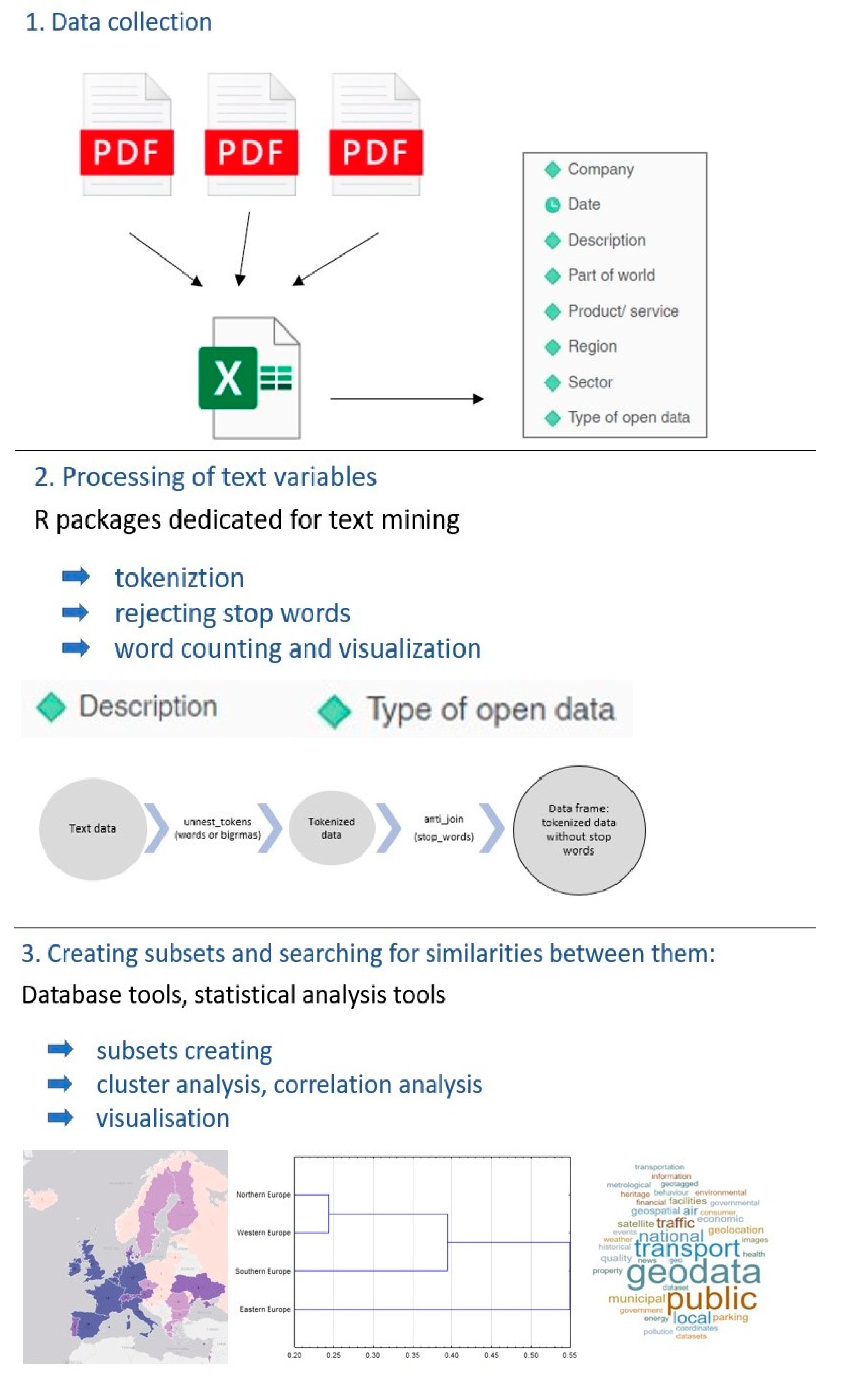


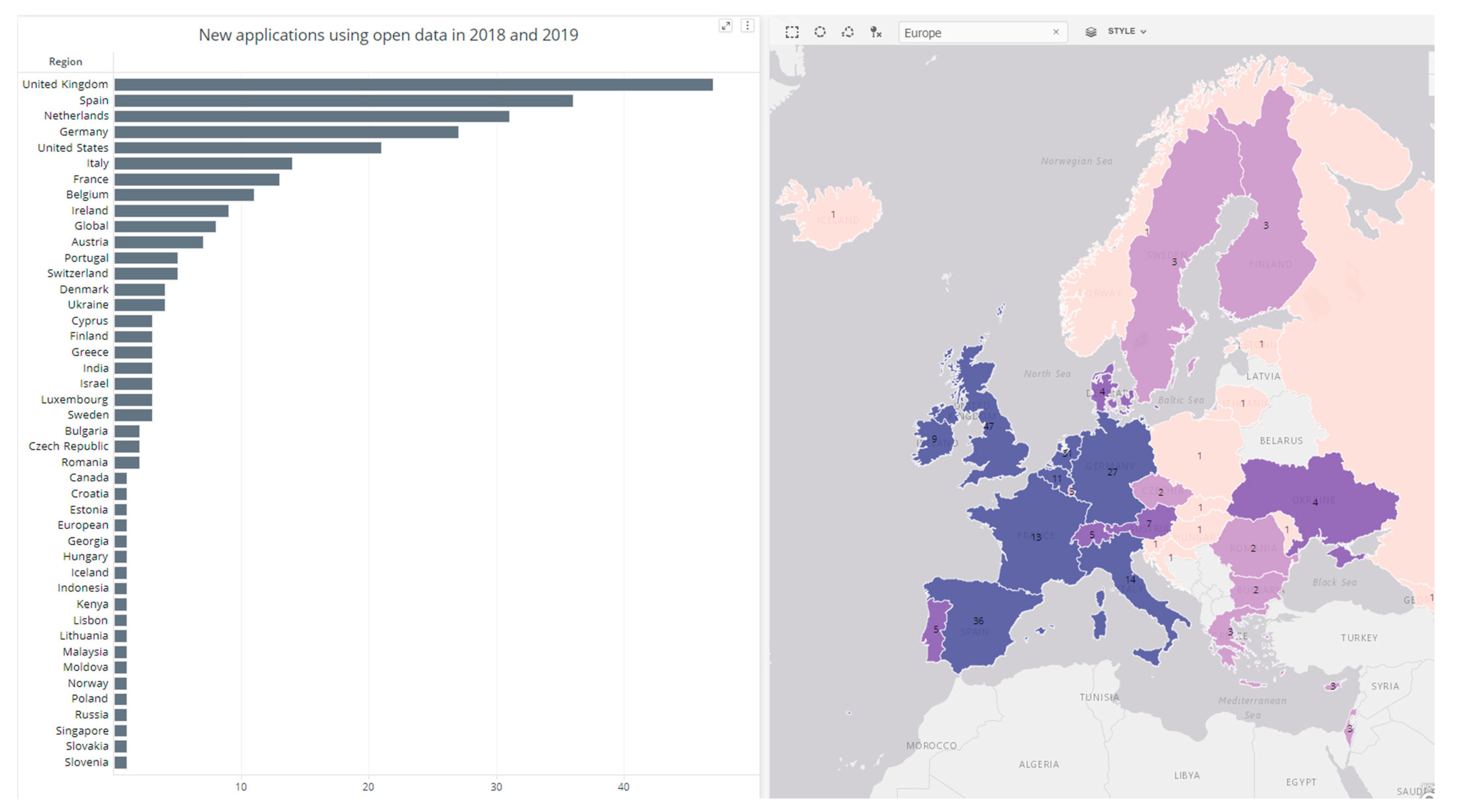

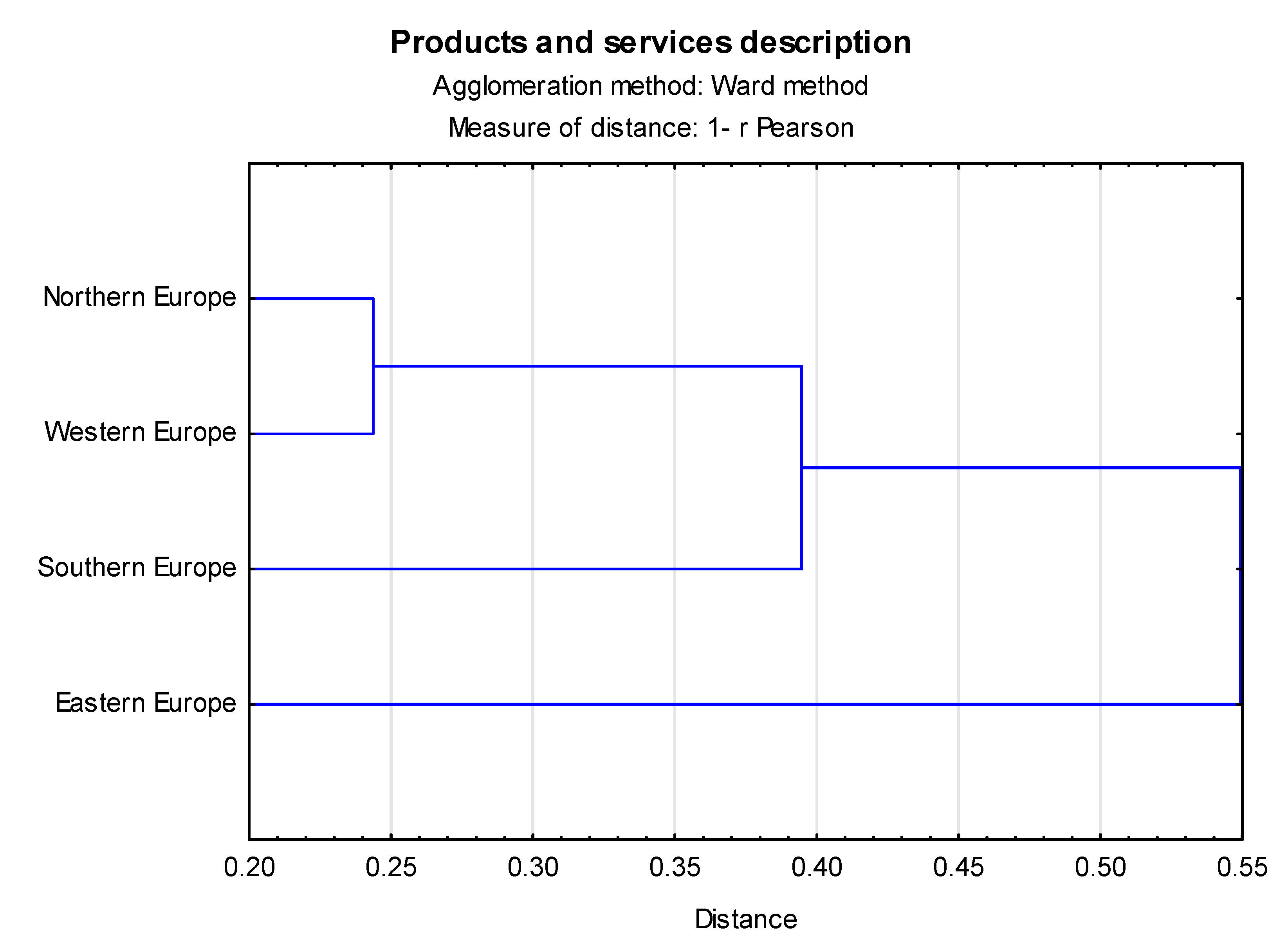

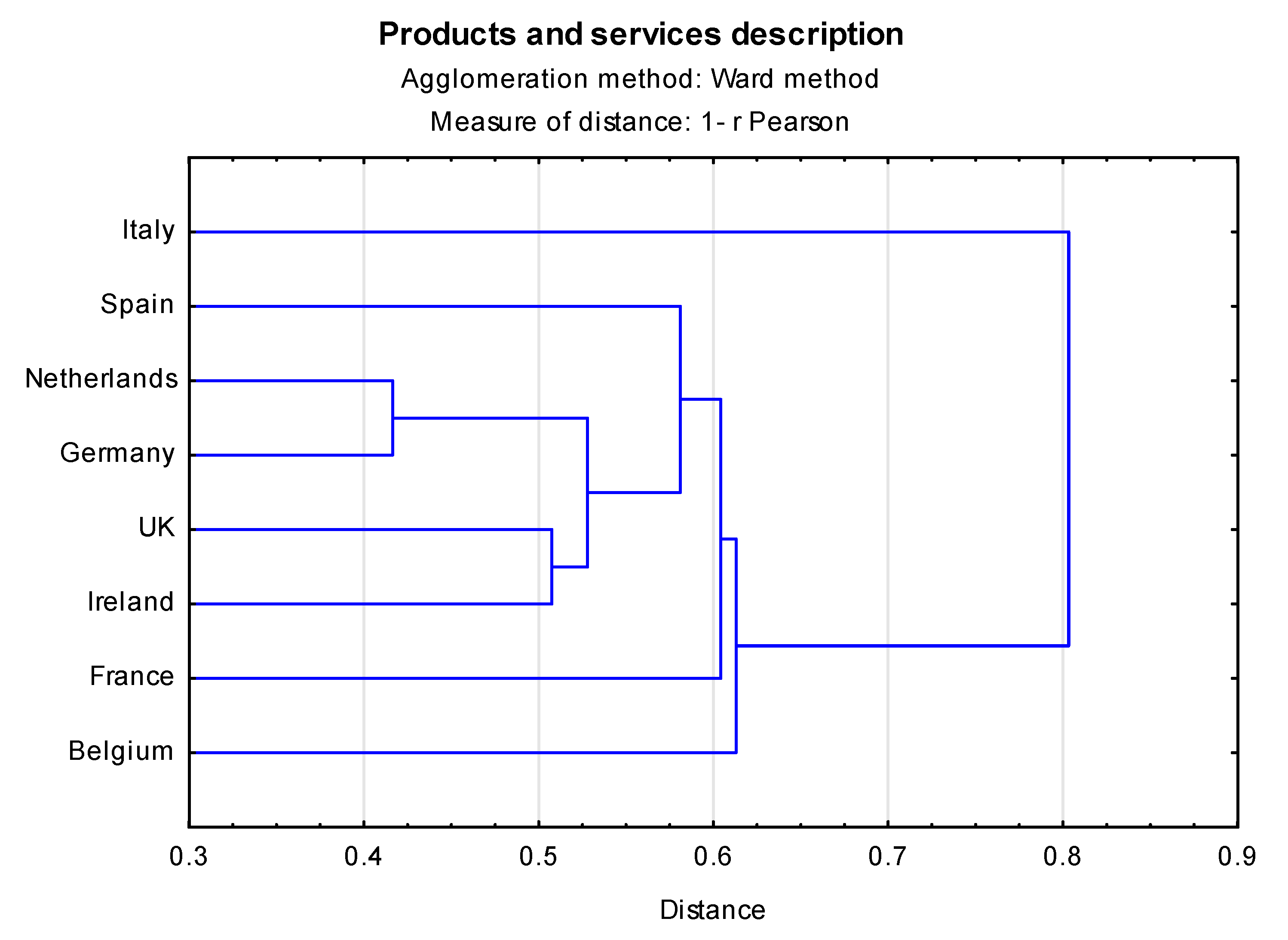
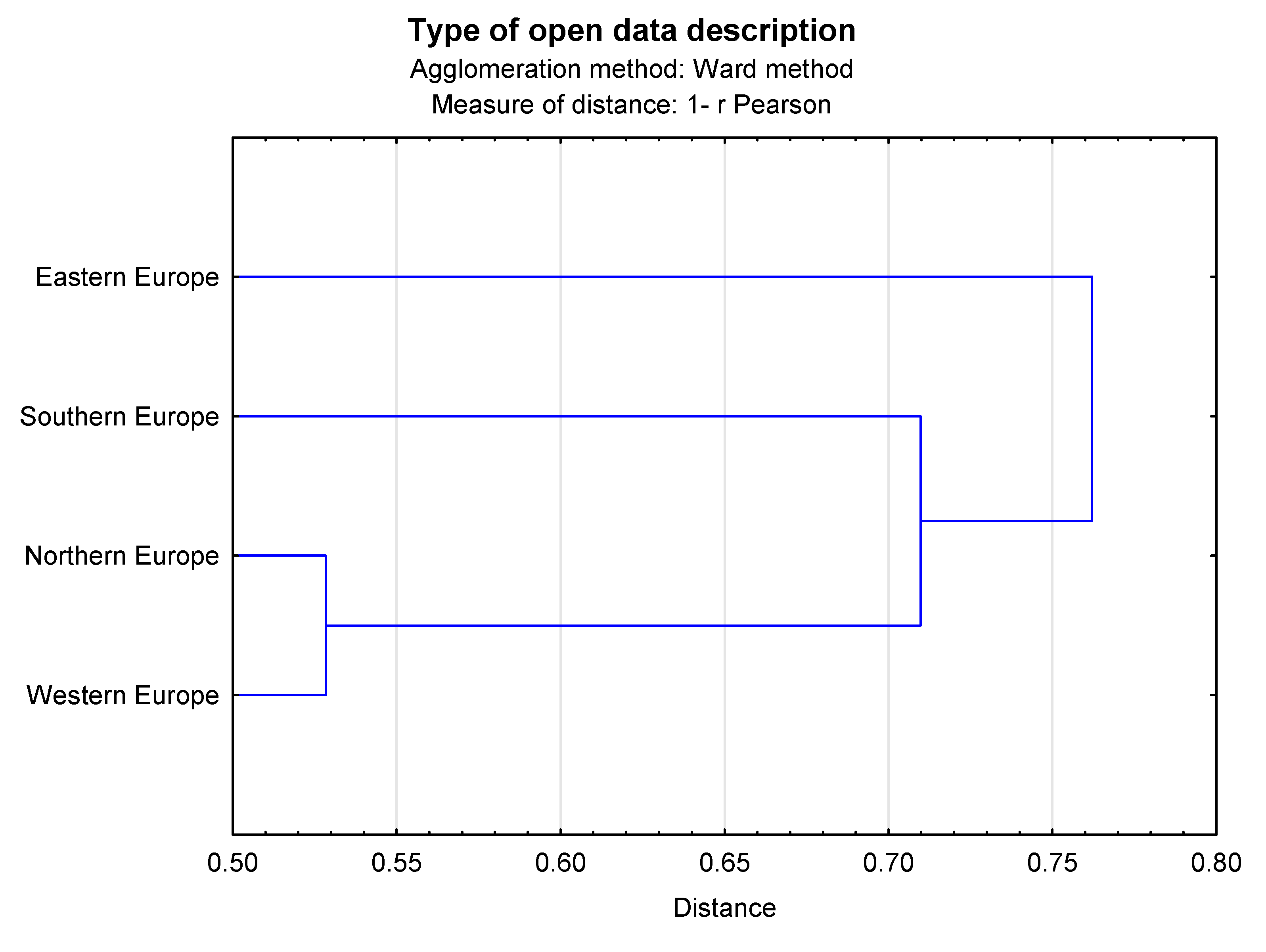
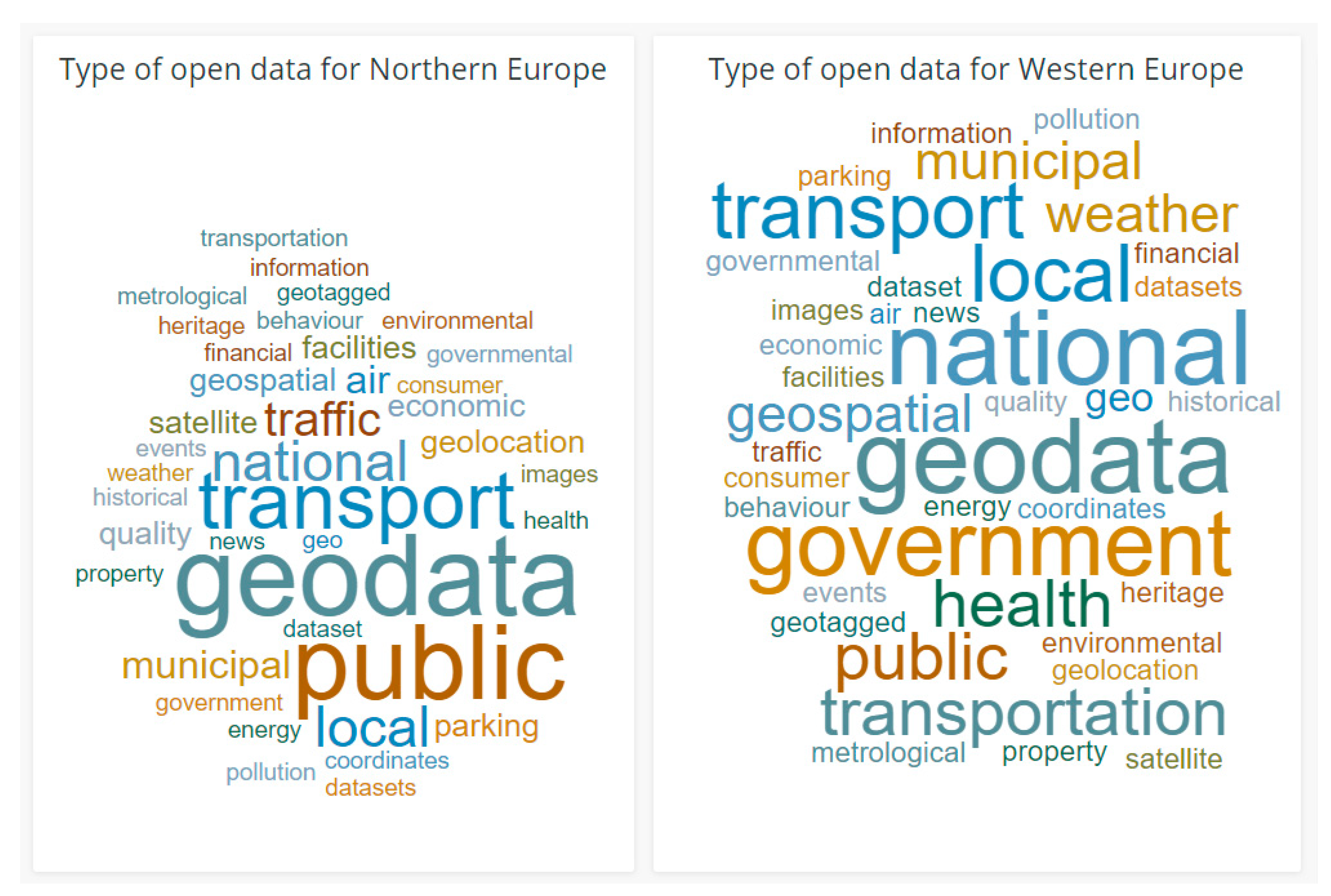
| Key Terms Describing Society 5.0 | Key Terms Describing Industry 4.0 |
|---|---|
| Artificial intelligence [51,55,56] Cyber-physical systems: intelligent transportation, smart manufacturing, regional care, smart food-chain [64,73,74] Data: data formats and interfaces standardization, utilization of standard data [24] Digitization [51,53] Expanding transparency and active participation in social issues [26,27,28,29,30]. Robotics [51,55] Equal opportunities for all people, integration of innovative technologies and society [51] Human-centered society [51,64,75] Imagination and creativity of people [51,56] Information, information platforms [46] Internet of things [55] Innovation as a driving force for new business and services [51] Open innovation [52] Regulatory of laws towards implementation of new technologies [56] “Society of imagination” [55] Sustainable Development: Sustainable Development Goals (SDGs), Dimensions of Sustainability [51,52,53] Super smart society [51,54] | Actuators [62,63] Automated Guided Vehicles [65] Adaptive robotics [66,67] Additive manufacturing [68] Big Data analytics [69] Cloud technologies [65,70] Cyber Industry Network [57] Cyber-physical infrastructure embedded systems [71,72] Cybersecurity [76,77] Digital factory [80] Hybrid production [65] Industrial internet—communication and networking [65] Internet of things [81] Mobile technologies [80] Radio-frequency identification (RFID) and Real-time locating system (RTLS) technologies [58] Sensors [63,64] Simulations [59] Smart factory [65,78], SmartFactory [79] Value creation due to technological transformation [51,56] Visualization technologies, such as virtual reality and augmented reality [65,66] |
| Variable | Description |
|---|---|
| Company | The name of the company that created the product or service based on open data |
| Date | Date of posting information about the product or service based on open data on Europortal |
| Description | Description of product or service based on open data |
| Part of world | Region of Europe (north, south, east, west) for which the product or service based on open data is intended |
| Region | Region for which the product or service based on open data is intended |
| Sector | Sector for which the product or service based on open data is intended |
| Type of open data | Description of type of open data |
| Word | n | Word | n | Word | n |
|---|---|---|---|---|---|
| data | 736 | transport | 52 | research | 36 |
| information | 341 | collects | 51 | create | 35 |
| users | 262 | access | 50 | government | 35 |
| application | 189 | aims | 49 | offers | 35 |
| public | 163 | location | 49 | air | 34 |
| website | 114 | business | 48 | food | 34 |
| platform | 104 | user | 47 | free | 34 |
| time | 93 | citizens | 46 | database | 33 |
| company | 92 | service | 44 | clients | 31 |
| map | 90 | enables | 41 | knowledge | 31 |
| real | 82 | city | 40 | projects | 31 |
| people | 80 | insights | 40 | statistics | 31 |
| national | 75 | search | 40 | tool | 31 |
| provide | 63 | traffic | 40 | makes | 30 |
| sources | 62 | european | 38 | management | 30 |
| based | 61 | helps | 37 | organisations | 30 |
| services | 61 | parking | 37 | accessible | 29 |
| local | 55 | transparency | 37 | analysis | 29 |
| quality | 54 | development | 36 | datasets | 29 |
| companies | 52 | interactive | 36 | maps | 29 |
| Bigram | n | Bigram | n | Bigram | n |
|---|---|---|---|---|---|
| real time | 63 | provide information | 8 | united kingdom | 6 |
| air quality | 26 | provide users | 8 | weather data | 6 |
| collects data | 26 | public sector | 8 | web based | 6 |
| public data | 22 | satellite images | 8 | website enables | 6 |
| public transport | 21 | social networks | 8 | alternative fueling | 5 |
| time information | 20 | business information | 7 | arrival times | 5 |
| real estate | 16 | information system | 7 | bike citizens | 5 |
| data sources | 15 | local authorities | 7 | business processes | 5 |
| data portal | 13 | accurate house | 6 | de sintra | 5 |
| additional information | 12 | artificial intelligence | 6 | geospatial data | 5 |
| easily accessible | 12 | data quality | 6 | helps people | 5 |
| enables users | 12 | enables people | 6 | helps users | 5 |
| user friendly | 12 | house price | 6 | land viewer | 5 |
| data visualisation | 10 | land insight | 6 | national governments | 5 |
| gathers data | 10 | machine learning | 6 | nearest public | 5 |
| interactive map | 9 | machine readable | 6 | parking spaces | 5 |
| collected data | 8 | public toilet | 6 | polling station | 5 |
| data driven | 8 | public transportation | 6 | predictive models | 5 |
| geographic information | 8 | traffic data | 6 | private sources | 5 |
| parking facilities | 8 | transport data | 6 | promotes transparency | 5 |
| Northern Europe | Western Europe | Eastern Europe | Southern Europe | |||||
| With Outliers | Without Outliers | With Outliers | Without Outliers | With Outliers | Without Outliers | With Outliers | Without Outliers | |
| Northern Europe | 1 | 1 | ||||||
| Western Europe | 0.867 | 0.532 | 1 | 1 | ||||
| Eastern Europe | 0.775 | 0.312 | 0.727 | 0.337 | 1 | 1 | ||
| Southern Europe | 0.821 | 0.465 | 0.811 | 0.443 | 0.775 | 0.303 | 1 | 1 |
| Word | n | Word | n |
|---|---|---|---|
| data | 268 | traffic | 7 |
| national | 37 | air | 6 |
| local | 27 | geospatial | 6 |
| geodata | 23 | dutch | 5 |
| public | 22 | geo | 5 |
| transport | 19 | parking | 5 |
| portals | 14 | real | 5 |
| government | 10 | satellite | 5 |
| environmental | 8 | statistics | 5 |
| health | 8 | cadastre | 4 |
| transportation | 8 | energy | 4 |
| weather | 8 | financial | 4 |
| agricultural | 7 | geographic | 4 |
| cultural | 7 | geographical | 4 |
| economic | 7 | quality | 4 |
| municipal | 7 |
| Issue | Bigram | Issue | Bigram |
|---|---|---|---|
| Human-oriented action | business information | Physical-to-digital-to-physical loop | additional information |
| business processes | artificial intelligence | ||
| easily accessible | collected data | ||
| enables people | collects data | ||
| enables users | data driven | ||
| helps people | data portal | ||
| helps users | data quality | ||
| local authorities | data sources | ||
| national governments | data visualisation | ||
| polling station | gathers data | ||
| promotes transparency | geographic information | ||
| provide users | geospatial data | ||
| social networks | information system | ||
| user friendly | interactive map | ||
| Sustainable development | accurate house | land insight | |
| air quality | land viewer | ||
| alternative fueling | machine learning | ||
| arrival times | machine readable | ||
| bike citizens | predictive models | ||
| house price | provide information | ||
| nearest public | public data | ||
| parking facilities | public sector | ||
| parking spaces | real time | ||
| public toilet | satellite images | ||
| public transport | time information | ||
| public transportation | weather data | ||
| real estate | web based | ||
| traffic data | website enables | ||
| transport data |
| Northern Europe | Western Europe | Eastern Europe | Southern Europe | |||||
| With Outliers | Without Outliers | With Outliers | Without Outliers | With Outliers | Without Outliers | With Outliers | Without Outliers | |
| Northern Europe | 1 | 1 | ||||||
| Western Europe | 0.966 | 0.472 | 1 | 1 | ||||
| Eastern Europe | 0.919 | 0.346 | 0.918 | 0.307 | 1 | 1 | ||
| Southern Europe | 0.922 | 0.425 | 0.905 | 0.246 | 0.864 | 0.204 | 1 | 1 |
Publisher’s Note: MDPI stays neutral with regard to jurisdictional claims in published maps and institutional affiliations. |
© 2021 by the authors. Licensee MDPI, Basel, Switzerland. This article is an open access article distributed under the terms and conditions of the Creative Commons Attribution (CC BY) license (http://creativecommons.org/licenses/by/4.0/).
Share and Cite
Sołtysik-Piorunkiewicz, A.; Zdonek, I. How Society 5.0 and Industry 4.0 Ideas Shape the Open Data Performance Expectancy. Sustainability 2021, 13, 917. https://doi.org/10.3390/su13020917
Sołtysik-Piorunkiewicz A, Zdonek I. How Society 5.0 and Industry 4.0 Ideas Shape the Open Data Performance Expectancy. Sustainability. 2021; 13(2):917. https://doi.org/10.3390/su13020917
Chicago/Turabian StyleSołtysik-Piorunkiewicz, Anna, and Iwona Zdonek. 2021. "How Society 5.0 and Industry 4.0 Ideas Shape the Open Data Performance Expectancy" Sustainability 13, no. 2: 917. https://doi.org/10.3390/su13020917
APA StyleSołtysik-Piorunkiewicz, A., & Zdonek, I. (2021). How Society 5.0 and Industry 4.0 Ideas Shape the Open Data Performance Expectancy. Sustainability, 13(2), 917. https://doi.org/10.3390/su13020917






